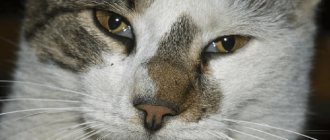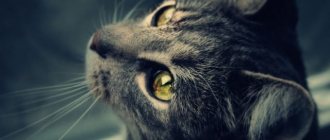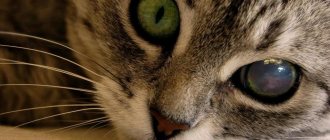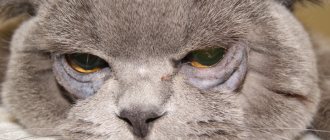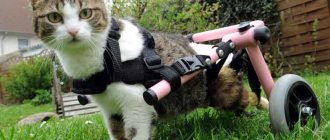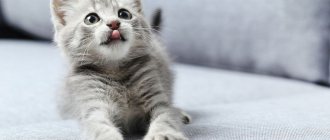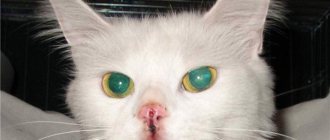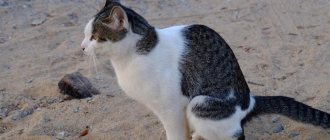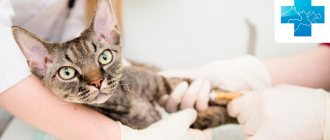The small thin film in the inner corner of the eye in cats is called the nictitating membrane, or third eyelid. Since ancient times, it has served as protection against dust and injury and moisturized the eye. The tear fluid secreted by the nictitating membrane wets the surface of the cornea when blinking and washes away dust particles to the inner corner of the eye.
Problems with the third eyelid become noticeable during pathological processes or diseases. Painful membrane prolapse requires attention from the cat owner and sometimes treatment under the supervision of a veterinarian.
What is this third eyelid?
As the cat Matroskin said, “Whiskers, paws and tail - these are my documents!” And veterinarians might add: and the third eyelid. Because not all mammals have it.
Human ancestors once had a nictitating membrane, but now it is a small fold at the inner corner of the eye, called the lacrimal. In cats, the membrane opens and sometimes reaches the middle of the eye.
The third eyelid, or nictitating membrane, is a thin film (light, sometimes pigmented) in the corner of the cat's eye, which protects the mucous membrane from damage and dust. It secretes a little tear fluid, which, when blinking, wets the surface of the eyeball and thus collects foreign particles, trapping bacteria.
This fold of mucosa is covered with immune tissue. The complex structure of the structure ensures the distribution of tear fluid and antibodies throughout the cornea. Most of the eyelid is hidden in the eye socket and does not normally attract attention. The nictitating membrane in a cat usually attracts the attention of owners when there is an injury or infection.
A cat's third eyelid becomes covered with a film or falls out for several reasons, and it is difficult for a non-specialist to identify the nature of the damage. The cat hides from the light, often scratches its face, and experiences itching. An animal cannot help itself, so caring owners take this responsibility upon themselves.
Symptoms
How can you tell if your pet needs an urgent visit to the vet? In the initial stages, the cat often begins to “wink” at the owner and avoids looking at light sources. Tears flow profusely from her eyes, and soon the discharge becomes mucous and quite thick. The animal acquires the habit of looking sideways at the world around it. In many cases, the eyelids themselves become inflamed and swollen, and the tissues of the organ become noticeably hot to the touch.
Intolerance to light reaches a peak stage; the animal cannot look at lamps or the sun at all. It begins to constantly rub its eyes with its paws, and this causes it severe pain. If you notice these symptoms in your pet, we advise you to contact your veterinarian immediately.
Causes of third eyelid prolapse in cats
In healthy animals, the third eyelid is visible only when blinking and tilting the head. In pathological situations, the nictitating membrane is always noticeable - this is a reason to contact a veterinary clinic. The appearance of a nictitating membrane can lead to loss of vision and cause a number of serious diseases. In addition, the third eyelid causes discomfort to the cat and interferes with a normal view of the outside world.
Allergy
Allergic conjunctivitis is not always associated with food components or ordinary dust. Sometimes it occurs with sensitivity to sunlight and household chemicals (laundry powder or deodorants, human cosmetics, floor cleaners and room disinfectants).
Allergic redness of the third eyelid may be accompanied by swelling of the larynx, redness of the skin, and lethargy of the pet. It is possible to identify an allergen in the blood only in a hospital setting. Then everything depends on the scale of the lesion: for mild cases of the disease, Zyrtec, Fenistil, Kestin are used, that is, antihistamines. In severe cases, the veterinarian prescribes hormonal treatment: Dexamethasone, Prednisolone.
Parasitosis
If your cat has a third eyelid due to parasites, it will need to be rinsed with cleansing drops. When using gels and drops for inflammation, you need to make sure that the cat does not wipe them with its paws.
If the problem is fleas or worms, you can deal with it at home. Antihelminthic measures can be carried out without a doctor’s prescription if the cat is completely healthy and has no allergies or chronic diseases. Kittens, pregnant and weakened individuals must consult a veterinarian before deworming.
Fleas are most often driven out with a spray or drops on the withers. Anti-flea collars can be used as prevention.
Complex cases of infection are treated under the supervision of a veterinarian. Sometimes therapy lasting 1-2 months is required for complete recovery.
Adenoma
A benign tumor of the third eyelid is called an adenoma. Externally, it is a voluminous pink formation that prevents the cat from closing its eye. The disease is dangerous because there is a risk of injury to the cornea and secondary infection.
If the tumor grows and causes concern, it is removed in surgery, while trying to preserve the nictitating membrane itself to avoid dry eye, conjunctivitis and blindness.
Foreign body rejection
Often, lacrimation and prolapse of the third eyelid contribute to the natural rejection of insects, small particles of dust or sand, and other foreign bodies that have entered the eye. Indoor cats and those that are outdoors have approximately the same likelihood of such injuries. Often the usual copious rinsing leads to recovery.
If a secondary infection occurs, the cat will require treatment.
Injuries
Injuries to the delicate membrane in kittens occur during a period of rapid growth. Due to curiosity and childhood clumsiness, they can damage any part of the eyes.
Adult animals, as a rule, avoid eye damage in everyday life. Cats that go outside may get into fights or damage the fold while fleeing from dogs. Therefore, there should be increased monitoring of walking pets: after a long absence from home, you need to examine the cat as a whole.
If the bleeding of the membrane is slight and there are no moving torn fragments, the damage will heal on its own. The main thing is that the pet does not scratch the injury with its paws and does not introduce an infection into the wound.
Getting infected
Fungi, viruses, and bacterial infections are insidious in that they can lead to complete loss of vision. If because of them the cat has a third eyelid, a set of measures will be needed:
- antifungal injections;
- antibiotic drops;
- pain reliever;
- antipyretic;
- drinking plenty of water;
- vitamins;
- immunostimulants.
There are situations when microbes were “targeted” in the ear, but they also grabbed the eyes nearby, then, for example, otitis media and inflammation of the conjunctiva are treated at the same time. A veterinarian will help you prescribe the medicine and dosage correctly. Getting rid of the infection on your own will not bring results, but will only worsen the pet’s condition.
Anatomical disorders
The most common disorders - cartilage eversion and lacrimal gland prolapse - can only be treated surgically.
A natural predisposition to prolapse (loss) is expressed in British, Persian and exotic breeds. Prolapse refers to the loss of the normal position of the gland, the structure of the tissue does not change. It would be a mistake to confuse prolapse with an adenoma (neoplasm).
The tissues are sutured, since removing the eyelid will lead to the development of keratoconjunctivitis sicca. This is a chronic disease, and owners will have to monitor the cat's eyes for the rest of his life. Therefore, veterinarians try to preserve the cat’s nictitating membrane at all costs.
During eversion, the curved part of the cartilage is removed, and the decision about the operation is made by the doctor. It identifies potential risks and can make a more or less accurate forecast.
Other diseases
Some diseases of the internal organ systems can lead to loss or enlargement of the third eyelid. Typically, the disease is in its acute stage during the period when it can affect the eyes. This:
- chronic somatic diseases, for example, renal failure;
- hormonal imbalances;
- damage by viruses (distemper, leptospirosis);
- recovery from anesthesia after surgery.
Each of these conditions requires treatment of the underlying cause. Viruses are especially dangerous - they can cause rapid death.
Operation
Despite some cases of non-surgical treatment of pets, surgery is the only solution in the vast majority of cases. The essence of this operation is that the surgeon carefully returns the bent piece of the eyelid to the correct position and secures it with special sutures that will not leave scars on the cat’s face.
Sutures placed on the eyelid during surgery are subsequently removed by a veterinarian
Usually the operation is performed in one go, but if the situation is especially severe, then moving and securing the eyelid can be carried out in several interventions, the number of which is determined by the surgeon after examination.
Preparing for surgery
Any surgical intervention, regardless of its complexity, requires anesthesia, which obliges the owner to follow several strict rules when preparing the pet for surgery. Among these rules are:
- Any food is excluded from the animal’s diet 12 hours (and preferably even 24 hours) before surgery. At the same time, the cat must maintain access to water;
- if the disease is at a severe stage, the damaged cornea of the eye is covered with a third eyelid, which acts as a protective layer;
- the animal's eyes (or eyes) are lubricated with tetracycline ointment and prescribed antiseptic drops are placed. Note that this point does not always take place - it is determined by the veterinarian.
Often, before surgery, the cat is prescribed special antibacterial drops.
Important! Since the cat will be under anesthesia during the operation, it is necessary to first deworm the animal, if possible. Otherwise, the worms may block the animal’s access to oxygen directly during surgery.
After operation
Perhaps the most important question for the owner of a sick pet is what are the cat's chances of making a full recovery? Fortunately, with entropion of the eyelid, the prognosis is very favorable - final cure is achieved in 90 to 95% of animals.
A cat undergoing eyelid inversion surgery
The effectiveness of the operation is influenced by the following factors:
- the cat's health status before surgery - the better the cat feels before surgery, the faster it comes to its senses after its completion;
- age of the pet - young animals tolerate anesthesia and recover on average faster than their more mature relatives;
- breed - as already noted, recovery is the hardest for sphinxes, but there are exceptions;
- the presence of other diseases that weaken the animal’s immunity.
Condition of the animal's eyelid before and after surgery
It should be remembered that the surgeon is not a magician. And even the most successful operation will not be able to bring the cat’s well-being back to normal if it is not taken care of appropriately at home. To help the pet recover completely, the owner must take the following simple steps:
- Put a protective collar on the cat that will not allow him to interact with the eye area. Of course, not every pet will be happy with such an accessory, but this collar is a temporary necessity;
- In the first days, carefully monitor any movements of the pet and do not let him make difficult jumps;
- instill antibiotics in the eyes in the form of drops - this will prevent any development of infection after surgery;
- treat the cat's stitches. The pet owner will learn more about what antiseptic agents are used for treatment and how exactly it is carried out from the attending physician.
You can read below about how to drip or lubricate a cat’s eyes with ointment with minimal damage to yourself and your pet.
How to treat a cat's eyes
In some situations, cats that react violently to anesthesia require sedatives that reduce affect and balance the pets.
Sutures are removed one and a half to two weeks after the operation. It is then that the veterinarian evaluates the final results and draws conclusions about further maintenance therapy.
A protective collar will prevent your pet from introducing infection into the operated eyelids
How to recognize the problem
Depending on the cause of the nictitating membrane, the veterinarian will select therapy. Self-medication is dangerous and can make the situation worse. If treatment is not started in a timely manner and therapy is selected incorrectly, there is a risk of complications and even loss of vision.
Symptoms
Prolapse of the third eyelid is manifested by enlargement, often by redness of the fold (the so-called cherry eye), lacrimation, and sometimes purulent discharge. The animal squints, rubs its eyes with its paws or scratches its muzzle on everything, and washes itself endlessly.
If a cat has a noticeable third eyelid, then problems with the digestive system cannot be ruled out. Observe the animal; if the film does not hide back on its own for several days, this is a reason to consult a doctor. Another cause for concern is the onset of the flu, when the eyes fester and the temperature rises.
The third eyelid should not always alarm owners - there are cases of its appearance due to physiology.
Signs of eye diseases
Often cats with prolapse of the third eyelid experience lacrimation, the pet constantly washes itself, is bothered by itching, squints its eyes, and blinks frequently. With close observation, you may notice spasms of the periorbital muscle, redness and swelling of the conjunctiva, mucous or even purulent discharge from the affected eye. Volumetric formations appear in the inner corners of the eyes, and the temperature may rise.
Prolapse of the third eyelid is dangerous for the animal due to the addition of a secondary infection. Therefore, if this pathology is detected in a pet, it is necessary to urgently show it to a veterinarian.
When everything is within normal limits
Sometimes the third eyelid is shown briefly (without discoloration, foreign discharge, or signs of inflammation) when the animal is sleeping. Normally, the membrane is visible when the animal tilts its head. This does not indicate illness and should not cause concern.
A kitten's third eyelid is observed in the first weeks of life, until the eyes open completely. Then it “resets” itself to its normal state. But if the film stretches over half the eye or completely covers it, you need to monitor the general condition of the animal and, if you suspect a disease, contact a veterinarian.
Why is the appearance of the third century dangerous?
In addition to the fact that the pet experiences discomfort, scratches its eyes, blinks intensely, it can suffer from diseases of the internal organs and parasites. There is only one symptom, but the causes are different, and all of them are unfavorable for the cat’s body.
Untreated eye infections are dangerous: they can lead to blindness or affect the brain. Benign tumors (adenomas) are dangerous, as they lead to the same consequences.
Infection with worms is unpleasant, because the animal has itching in the eyes and under the tail, and has a poor appetite. Regular anti-parasitic procedures are recommended for all pets - even those that do not go outside.
Bacteria, fungi, viruses, allergies, as mentioned above, also lead to inflammation of the third eyelid in cats. Many infectious diseases can lead to irreversible complications and death, and allergies can develop into bronchial asthma.
Even when all the bad things are over, the third eyelid can fall out due to stress and weakened immunity of the animal, as well as after undergoing operations. Here you need to choose the right vitamins, under the guidance of a veterinarian, and create a calm, cozy atmosphere at home.
Basic information
Most cases of primary entropion of the eyelids occur in very young cats, who have just turned six months old. As a rule, a sick animal can only be cured with timely surgery. But in some cases, volvulus goes away spontaneously, without any medical intervention. But this only applies to young cats. It is important to understand that even in relatively severe cases you will still have to wait until at least four months of age to have surgery.
Trauma, chronic inflammation, and many eye diseases can lead to secondary entropion. This happens most often in cats (as we have already discussed). Many owners take the animal to the veterinarian, who corrects the eyelid, but the problem appears again. The fact is that simultaneously with the entropion of the eyelid, it is necessary to cure the disease due to which the pathology developed.
Treatment of pathological processes
If the eye problem does not go away within a couple of days, you should contact your veterinarian. He will prescribe a treatment regimen and medications appropriate for the cause.
Prescription of drugs
Treatment of nictitating membrane prolapse is based on identifying and eliminating its main causes. If parasitic infestation is detected, then anthelmintic therapy is carried out followed by prophylaxis.
In case of allergic conjunctivitis, the animal is protected from contact with possible allergens and treated with antihistamines and hormonal agents.
Infectious diseases are treated comprehensively using local and systemic specific therapy with antimicrobial, antiviral and fungicidal (antifungal) agents. Additionally, antipyretics and immunomodulatory drugs are used.
Somatic diseases are treated with appropriate medications and corrected with medicinal foods. Foreign objects and foreign bodies are removed on an outpatient basis or surgically.
Treatment of an eye injury boils down to the use of anesthetic drops to alleviate the cat’s condition and prevent secondary infection. Treatment is carried out until the symptoms of third eyelid prolapse completely disappear.
Surgical intervention
Surgical treatment of the third eyelid in a cat depends on causes not related to diseases of the internal organs. It is required for adenoma, because because of this “pink bean” the animal cannot completely close its eyes, which means that the gates to infections and injuries are open.
When removing a tumor, they try to preserve the membrane at all costs, because it is responsible for the distribution of tear fluid and local immunity. During cartilage eversion, again, not all of the cartilage is removed, but only its convex part.
After the operation, antibiotic drops, healing ointments and an “Elizabethan” collar are usually used so that the cat does not harm itself with its paws - it does not scratch its face and does not wash itself for some time.
In general, there are not many indications for surgery and they occur infrequently. In other cases, one visit to the clinic and home treatment recommended by a veterinarian is enough.
What not to do
Self-medication and diagnosis by watching videos on the Internet have not yet helped a single pet. Therefore, if you have any alarming symptoms, you need to go to the veterinarian and start treatment.
Absolutely forbidden:
- use medications without a doctor’s prescription;
- try to remove foreign bodies from the eye yourself;
- try to straighten the third eyelid;
- violate the integrity, squeeze out, cut the “bean”;
- help the cat scratch its eyes.
Just an idea of treatment is not enough - you need skills, tools, equipment for diagnosis. This is only available at the doctor's office. And at home, the only safe manipulations are washing and instilling drops, and not all of them - only those that the doctor has approved.
Prolapse of the third eyelid in cats requires treatment in cases where the color, shape and size of the fold have changed. In other cases, you can consult a veterinarian by phone and do the rinsing yourself.
Prevention of the problem
Breeders are advised to regularly examine their pets' eyes and the area around them, perform eye hygiene, and monitor the cat's diet and amount of fluid consumed. Good nutrition will protect your four-legged family friend from many diseases.
If an animal becomes ill with viruses, it is important to follow the care recommendations, remove mucous discharge from the eyes and nose, add vitamin complexes to the diet and provide the required amount of clean water. After your pet has recovered, you should definitely take it to the veterinarian so that the specialist can give recommendations on how to prevent relapses.
To prevent disease and reduce the likelihood of complications, vaccinate the animal in accordance with its age and health status, examine it after each walk, add vitamins to the diet, and do not expose it to stress. These simple recommendations will help maintain your pet's vision and well-being.
The article is for informational purposes only. Contact your veterinarian!
Do you like the article? 159
